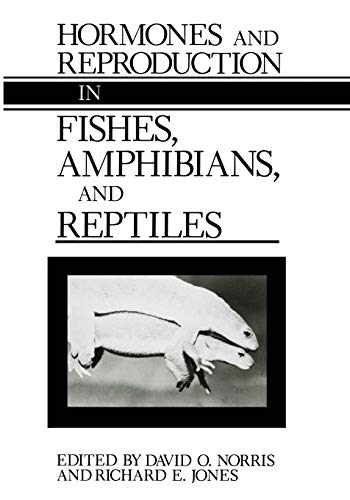Articoli correlati a Hormones and Reproduction in Fishes, Amphibians, and...

Le informazioni nella sezione "Riassunto" possono far riferimento a edizioni diverse di questo titolo.
Le informazioni nella sezione "Su questo libro" possono far riferimento a edizioni diverse di questo titolo.
- EditoreSpringer Verlag
- Data di pubblicazione2011
- ISBN 10 1461290422
- ISBN 13 9781461290421
- RilegaturaCopertina flessibile
- Numero di pagine640
- RedattoreNorris David O., Jones Richard E.
Compra nuovo
Scopri di più su questo articolo
Spese di spedizione:
EUR 23,00
Da: Germania a: U.S.A.
I migliori risultati di ricerca su AbeBooks
Hormones and Reproduction in Fishes, Amphibians, and Reptiles
Descrizione libro Taschenbuch. Condizione: Neu. This item is printed on demand - it takes 3-4 days longer - Neuware -Comparative endocrinology is one of the most rapidly developing subdis ciplines within the field of endocrinology, and it is having a significant impact on research at the molecular, cellular, organisma1 and environmental levels. Much of the current ferment in endocrinology is in reproductive endocrinology. The purpose of this volume on hormones and reproduction in fishes, amphibians and reptiles is to summarize our present understandings and to identify important research problems to be addressed in the area of comparative reproductive endocrinology. It was inspired by the gathering at Copper Mountain, Colorado, of eminent endocrine scientists from around the world on the occasion of the Tenth International Symposium on Comparative Endocrinology in July, 1985. While preparing for that meeting, we decided that a special volume on reproductive endocrinology was needed to summarize what is known and to stimulate research in particular directions. Why do we emphasize fishes, amphibians and reptiles First, knowledge about the reproductive endocrinology of these ectothermic vertebrates can provide a clearer picture of the evolution of reproductive hormones and their effects on target organs. This comparative approach can lead to new theories about the evolution of reproductive control mechanisms. Second, studies concerning the reproductive endocrinology of 'lower' vertebrates can result in development of 'model systems' for application to studies of birds and mammals. Indeed, information about the patterns of reproductive control in ectothermic vertebrates can tell us which are evolutionarily stable and which are labile. 640 pp. Englisch. Codice articolo 9781461290421
Hormones and Reproduction in Fishes, Amphibians, and Reptiles [Paperback ]
Descrizione libro Soft Cover. Condizione: new. Codice articolo 9781461290421
Hormones and Reproduction in Fishes, Amphibians, and Reptiles
Descrizione libro Condizione: New. Codice articolo ABLIING23Mar2716030030244
Hormones and Reproduction in Fishes; Amphibians; and Reptiles
Print on DemandDescrizione libro Condizione: New. PRINT ON DEMAND Book; New; Fast Shipping from the UK. No. book. Codice articolo ria9781461290421_lsuk
Hormones and Reproduction in Fishes, Amphibians, and Reptiles
Descrizione libro Condizione: New. Codice articolo 4191589
Hormones and Reproduction in Fishes, Amphibians, and Reptiles
Descrizione libro Paperback / softback. Condizione: New. This item is printed on demand. New copy - Usually dispatched within 5-9 working days. Codice articolo C9781461290421
Hormones and Reproduction in Fishes, Amphibians, and Reptiles
Descrizione libro Taschenbuch. Condizione: Neu. Druck auf Anfrage Neuware - Printed after ordering - Comparative endocrinology is one of the most rapidly developing subdis ciplines within the field of endocrinology, and it is having a significant impact on research at the molecular, cellular, organisma1 and environmental levels. Much of the current ferment in endocrinology is in reproductive endocrinology. The purpose of this volume on hormones and reproduction in fishes, amphibians and reptiles is to summarize our present understandings and to identify important research problems to be addressed in the area of comparative reproductive endocrinology. It was inspired by the gathering at Copper Mountain, Colorado, of eminent endocrine scientists from around the world on the occasion of the Tenth International Symposium on Comparative Endocrinology in July, 1985. While preparing for that meeting, we decided that a special volume on reproductive endocrinology was needed to summarize what is known and to stimulate research in particular directions. Why do we emphasize fishes, amphibians and reptiles First, knowledge about the reproductive endocrinology of these ectothermic vertebrates can provide a clearer picture of the evolution of reproductive hormones and their effects on target organs. This comparative approach can lead to new theories about the evolution of reproductive control mechanisms. Second, studies concerning the reproductive endocrinology of 'lower' vertebrates can result in development of 'model systems' for application to studies of birds and mammals. Indeed, information about the patterns of reproductive control in ectothermic vertebrates can tell us which are evolutionarily stable and which are labile. Codice articolo 9781461290421

